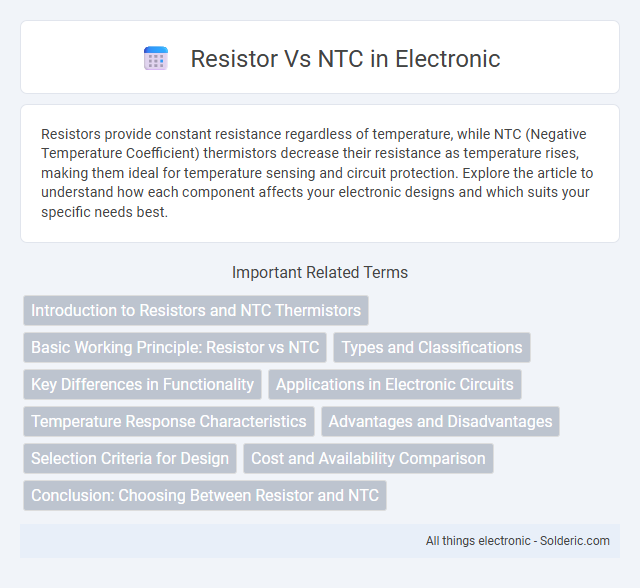Resistors provide constant resistance regardless of temperature, while NTC (Negative Temperature Coefficient) thermistors decrease their resistance as temperature rises, making them ideal for temperature sensing and circuit protection. Explore the article to understand how each component affects your electronic designs and which suits your specific needs best.
Comparison Table
| Feature | Resistor | NTC Thermistor |
|---|---|---|
| Definition | Passive electrical component limiting current flow | Temperature-dependent resistor with Negative Temperature Coefficient |
| Resistance Behavior | Constant resistance value | Resistance decreases as temperature rises |
| Primary Use | Current limiting, voltage division, biasing circuits | Temperature sensing, inrush current limiting |
| Material | Carbon film, metal film, wirewound | Ceramic or polymer with semiconductor properties |
| Temperature Sensitivity | Minimal to none | High sensitivity to temperature changes |
| Accuracy | High stability and fixed tolerance | Variable, depends on temperature range |
| Applications | Electronic circuits, signal conditioning | Temperature sensors, thermal protection |
Introduction to Resistors and NTC Thermistors
Resistors limit current flow and divide voltage in electronic circuits using fixed resistance values, essential for controlling circuit behavior. NTC thermistors, or Negative Temperature Coefficient thermistors, decrease resistance as temperature rises, providing precise temperature sensing and protection. Understanding your choice between these components depends on whether you need stable resistance or temperature-dependent response.
Basic Working Principle: Resistor vs NTC
A resistor operates by providing a fixed opposition to electric current, converting electrical energy into heat with resistance remaining constant regardless of temperature. In contrast, an NTC (Negative Temperature Coefficient) thermistor changes its resistance inversely with temperature: as the temperature rises, the resistance decreases due to increased charge carrier mobility. This temperature-dependent resistance characteristic makes NTC thermistors suitable for temperature sensing and inrush current limiting applications, unlike standard resistors with stable resistance values.
Types and Classifications
Resistors are classified primarily by material composition into carbon film, metal oxide, and wire-wound types, each offering distinct tolerance and power ratings suitable for varied electronic applications. NTC thermistors, a subset of resistors, are categorized based on their beta value and resistance range, with common types including bead, disc, and chip, optimized for temperature sensing and inrush current limiting. Understanding these classifications allows for precise selection in circuit design, ensuring performance reliability under specific environmental and electrical conditions.
Key Differences in Functionality
Resistors provide a constant resistance regardless of temperature, ensuring stable current flow in electronic circuits, while NTC (Negative Temperature Coefficient) thermistors decrease resistance as temperature increases, allowing them to function as temperature sensors or inrush current limiters. The fixed resistance of resistors supports voltage regulation and current limiting, whereas the temperature-dependent resistance of NTC thermistors enables dynamic response to thermal variations. These distinct functionalities make resistors ideal for steady-state applications, whereas NTC thermistors are essential for temperature monitoring and protection mechanisms.
Applications in Electronic Circuits
Resistors are fundamental components used in electronic circuits for current limiting, voltage division, and signal conditioning, providing predictable and stable resistance values. NTC thermistors specifically serve temperature sensing and compensation roles, as their resistance decreases with increasing temperature, enabling precise thermal management in applications such as temperature monitoring, circuit protection, and temperature-dependent switching. Both components are crucial in ensuring circuit stability and reliability but are chosen based on their fixed or temperature-dependent resistance characteristics.
Temperature Response Characteristics
Resistors exhibit a relatively constant resistance over a wide temperature range, with a minimal temperature coefficient of resistance (TCR), ensuring stable performance in circuits requiring minimal variation. NTC (Negative Temperature Coefficient) thermistors display a significant decrease in resistance as temperature rises, enabling precise temperature sensing and rapid response to thermal changes. The distinct difference in temperature response characteristics makes resistors ideal for stable current limiting, while NTC thermistors excel in temperature measurement and thermal protection applications.
Advantages and Disadvantages
Resistors provide stable and predictable resistance values, offering precise control in electrical circuits with minimal temperature fluctuation effects, making them ideal for fixed resistance applications. NTC thermistors offer temperature-dependent resistance, enabling accurate temperature sensing and protection in circuits, but their resistance varies non-linearly with temperature and can be less stable over time. While resistors excel in consistent performance and durability, NTC devices are advantageous for thermal monitoring but require calibration and careful consideration of their temperature response characteristics.
Selection Criteria for Design
Selecting the right resistor or NTC thermistor for your design depends on factors such as resistance range, tolerance, temperature coefficient, and power rating. Resistors offer precise resistance values with low temperature sensitivity, ideal for circuits requiring stable current or voltage control. NTC thermistors provide temperature-dependent resistance, making them suitable for applications involving temperature sensing or compensation within specific temperature ranges.
Cost and Availability Comparison
Resistors are generally more cost-effective and widely available than NTC thermistors, due to their simpler construction and broader application across electronics. NTC thermistors, which provide temperature-dependent resistance, often come at a higher price point and may have limited availability depending on the required temperature range and precision. When considering your project budget and component sourcing, standard resistors offer greater affordability and easier procurement compared to NTC devices.
Conclusion: Choosing Between Resistor and NTC
Choosing between a resistor and an NTC thermistor depends on the application's specific requirements for temperature sensitivity and stability. Resistors provide a fixed resistance, ideal for precise, consistent electrical circuits, while NTC thermistors offer variable resistance that decreases with temperature, suited for temperature sensing and inrush current limiting. Selecting the appropriate component enhances circuit performance, with NTCs favored in thermal management and resistors preferred for stable, invariant resistance needs.
resistor vs NTC Infographic

 solderic.com
solderic.com